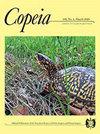菲律宾蛇科一小型新属一新种
IF 2.6
Q2 Agricultural and Biological Sciences
引用次数: 5
摘要
菲律宾群岛是一个生物多样性特别丰富的地区,包括至少112种陆地蛇,来自12科41属。最近,环蝇科(原Lamprophiidae: Cyclocorinae)被认为是菲律宾特有的一个独特的科,包含4个属:环蝇科(Cyclocorus)、Hologerrhum、Myersophis和Oxyrhabdium。在这里,我们描述了来自菲律宾萨马岛和莱特岛的另一个环虫属和种Levitonius mirus,新属和新种。新属Levitonius与Myersophis和Oxyrhabdium亲缘关系最密切,具有相同的骨骼特征;新属,不同于所有这些分类群的体型、鳞片和其他特征。骨骼和其他表型数据表明,新属Levitonius是穴居的,可能专门以蚯蚓为食。新属新种,最大总长度为172毫米,是兔总目中已知最小的种。我们的研究结果强调了萨马岛和莱特岛的未来工作的必要性,这两个岛屿受到系统学家的关注相对较少,部分原因是主流的生物地理学范式预测(不一定正确)这些岛屿只是棉兰老岛动物区陆生脊椎动物的一个巢状动物群子集。在这些陆地上发现了一种截然不同且在系统发育上存在差异的蛇系,这一发现加入了众多相关研究,呼吁对更新世聚合岛复合体模型(PAIC多样化范式)生物地理框架进行全面重新考虑。本文章由计算机程序翻译,如有差异,请以英文原文为准。
A New, Miniaturized Genus and Species of Snake (Cyclocoridae) from the Philippines
The Philippine archipelago is an exceptionally biodiverse region that includes at least 112 species of land snakes from 41 genera and 12 families. Recently, Cyclocoridae (formerly Lamprophiidae: Cyclocorinae) was proposed as a distinct, Philippine-endemic family, containing four genera: Cyclocorus, Hologerrhum, Myersophis, and Oxyrhabdium. Here, we describe an additional cyclocorid genus and species, Levitonius mirus, new genus and species, from Samar and Leyte Islands, Philippines. Molecular data support Levitonius, new genus, to be most closely related to Myersophis and Oxyrhabdium, and it shares multiple skeletal characteristics with these genera; Levitonius, new genus, differs from all of these taxa in body size, scalation, and other characters. Skeletal and other phenotypic data suggest that Levitonius, new genus, is fossorial and likely has a diet that is specialized on earthworms. Levitonius mirus, new genus and species, has a maximum total length of 172 mm and is at present the smallest known species in Elapoidea. Our results highlight the need for future work on Samar and Leyte Islands, which have received relatively little attention from systematists, in part because of a prevailing biogeographic paradigm that predicted (not necessarily correctly) that these islands would simply have a nested faunal subset of the Mindanao faunal region land vertebrates. The discovery of a strikingly distinct and phylogenetically divergent snake lineage on these landmasses joins numerous related studies calling for a wholesale reconsideration of the Pleistocene Aggregate Island Complex model (the PAIC paradigm of diversification) biogeographic framework.
求助全文
通过发布文献求助,成功后即可免费获取论文全文。
去求助
来源期刊

Copeia
生物-动物学
CiteScore
2.10
自引率
0.00%
发文量
0
审稿时长
6-12 weeks
期刊介绍:
Founded in 1913, Copeia is a highly respected international journal dedicated to the publication of high quality, original research papers on the behavior, conservation, ecology, genetics, morphology, evolution, physiology, systematics and taxonomy of extant and extinct fishes, amphibians, and reptiles. Copeia is published electronically and is available through BioOne. Articles are published online first, and print issues appear four times per year. In addition to research articles, Copeia publishes invited review papers, book reviews, and compiles virtual issues on topics of interest drawn from papers previously published in the journal.
 求助内容:
求助内容: 应助结果提醒方式:
应助结果提醒方式:


